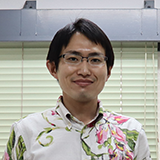|
Title |
Associate Professor |
|
Researcher Number(JSPS Kakenhi) |
60760163 |
|
Date of Birth |
1984 |
|
Laboratory Address |
1 Senbaru,Nishihara,Okinawa |
|
Mail Address |
|
|
Laboratory Phone number |
+81-98-895-8613 |
|
|
|
Yasuda Keita
|
|
|
Current Affiliation Organization 【 display / non-display 】
-
Duty University of the Ryukyus Faculty of Engineering School of Engineering_Energy and Environment Program Associate Professor
-
Charge of Lecture University of the Ryukyus Graduate School of Engineering and Science Thermal and Fluid Engineering Associate Professor
-
Charge of Lecture University of the Ryukyus Graduate School of Engineering and Science Material,Structural and Energy Engineering Associate Professor
University 【 display / non-display 】
-
2003.04-2007.03
Keio University Faculty of Science and Engineering Department of Mechanical Engineering Graduated
Graduate School 【 display / non-display 】
-
2007.04-2009.03
Keio University Graduate School, Division of Science and Engineering School of Science for Open and Environmental Systems Master's Course Completed
-
2009.04-2015.03
Keio University Graduate School, Division of Science and Engineering School of Science for Open and Environmental Systems Doctor's Course Completed
Academic degree 【 display / non-display 】
-
Keio University - Ph.D. in Engineering
External Career 【 display / non-display 】
-
2009.04-2010.03
-
2010.04-2012.03
-
2010.05-2010.10
Visiting Scholar in Colorado School of Mines
-
2015.04-2017.03
University of the Ryukyus, Faculty of Engineering, Department of Mechanical Systems Engineering, Instructor
-
2017.04-2022.05
University of the Ryukyus, Faculty of Engineering, School of Engineering, Energy and Environment Program, Instructor
Research Interests 【 display / non-display 】
-
Physical Chemistry and Engineering of Clathrate Hydrates
Research Areas 【 display / non-display 】
-
Manufacturing Technology (Mechanical Engineering, Electrical and Electronic Engineering, Chemical Engineering) / Thermal engineering
Thesis 【 display / non-display 】
-
氷点下温度域におけるクラスレートハイドレートの相平衡条件と結晶構造
2015.03
Published Papers 【 display / non-display 】
-
Eutectic conditions of carbon dioxide clathrate hydrate and sodium Chloride: Implications for zero liquid discharge seawater desalination
Akari Gibo, Seiya Nakao, Ryo Ohmura, Keita Yasuda
Journal of Industrial and Engineering Chemistry ( Elsevier ) Available online 22 December 2024 2024.12 [ Peer Review Accepted ]
Type of publication: Research paper (scientific journal)
-
Access this article
-
-
Thermophysical Properties of Clathrate Hydrates with Various Guests for Novel Technologies: A Review
Keita Yasuda, Ryo Ohmura
International Journal of Thermophysics ( Springer Nature ) 45 139 2024.10 [ Peer Review Accepted ]
Type of publication: Research paper (scientific journal)
-
Access this article
-
-
Carbon Dioxide Clathrate Hydrate Formation and Mass Balance Calculation: A Laboratory Experiment
Keita Yasuda, Izuru Senaha
Journal of Chemical Education ( ACS Publications ) 101 3969 - 3974 2024.09 [ Peer Review Accepted ]
Type of publication: Research paper (scientific journal)
-
Access this article
-
-
Mist cooling lithium–ion battery thermal management system for hybrid electric vehicles
Aoto Teranishi, Takuma Kurogi, Izuru Senaha, Shoichi Matsuda, Keita Yasuda
Applied Energy ( Elservier ) 364 123214 2024.06 [ Peer Review Accepted ]
Type of publication: Research paper (scientific journal)
-
Access this article
-
-
Phase equilibrium conditions in carbon dioxide + cyclopentane double clathrate hydrate forming system coexisting with sodium chloride aqueous solution
Kouki Mekaru, Takuto Miyagi, Ayaka Mishima, Isami Uehara, Ryo Ohmura, Keita Yasuda
Journal of Chemical Thermodynamics ( Elservier ) 189 107185 2024.02 [ Peer Review Accepted ]
Type of publication: Research paper (scientific journal)
-
Access this article
-
Other Papers 【 display / non-display 】
-
Phase Equilibrium Conditions in Carbon Dioxide + Cyclopentane Double Clathrate Hydrate Forming System for Development of Seawater Desalination Technology
Hideya Suzuki, Kouki Mekaru, Takuto Miyagi, Ayaka Mishima, Isami Uehara, Keita Yasuda
2024 6th International Conference on Resources and Environmental Research XG6002-A 2024.12 [Refereed]
-
Phase Equilibrium Condition Measurements for Dual-Functional Technology of Clathrate Hydrate-Based Seawater Desalination and Carbon Capture
Toshikazu Sasaki, Kouki Mekaru, Toru Kubonaka, Shosei Morizumi, Keita Yasuda
2024 6th International Conference on Resources and Environmental Research XG6004-A 2024.12 [Refereed]
-
Interfacial Tension Measurements in Carbon Dioxide and Seawater System: An Implication for Clathrate Hydrate-Based Seawater Desalination
Shun Tsunekawa, Suzuna Yamaguchi, Kazuma Ishikawa, Ayushman Tripathi, Keita Yasuda
2024 6th International Conference on Resources and Environmental Research XG6003-A 2024.12 [Refereed]
-
Phase Equilibrium Conditions in Cyclopentane Clathrate Hydrate Forming Systems Coexisting with Sodium Chloride Aqueous Solutions
Toshikazu Sasaki, Keitatsu Kamochi, Ayushman Tripathi, Masanao Taoka, Ryo Ohmura, Keita Yasuda
The 12th International Conference on Separation Science and Technology 109 2023.11 [Refereed]
-
Relative Density of Carbon Dioxide Clathrate Hydrate and Sodium Chloride Aqueous Solution: Implications for Desalination Processes
Shun Tsunekawa, Akari Gibo, Toshiyuki Tanaka, Sayaka Shiraishi, Ryo Ohmura, Keita Yasuda
The 12th International Conference on Separation Science and Technology 109 2023.11 [Refereed]





